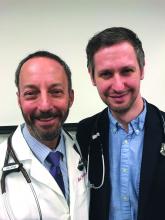Guidelines issued jointly by the Endocrine Society and the European Society for Endocrinology provide clinicians with a clear consensus approach to male hypogonadism, commonly referred to by patients as “low T.” Hypogonadism results from “the failure of the testes to produce physiological concentrations of testosterone and/or a normal number of spermatozoa due to pathology at one or more levels of the hypothalamic-pituitary-testicular axis,” according to the definition that serves as the basis for the guidelines.
Primary hypogonadism is caused by abnormalities at the testicular level, and secondary hypogonadism is caused by a defect of the hypothalamic pituitary axis. The two can be distinguished by elevated gonadotropin levels (LH and FSH) in primary hypogonadism, which rise in response to low testosterone levels. In secondary hypogonadism, gonadotropin levels are low or inappropriately normal. Causes of secondary hypogonadism include hyperprolactinemia, severe obesity, iron overload syndromes, opioid use, glucocorticoids, or androgen-deprivation therapy, androgenic-anabolic steroid withdrawal syndrome, idiopathic hypogonadotropic hypogonadism, hypothalamic or pituitary tumors or infiltrative disease, head trauma, and pituitary surgery or irradiation.The causes of hypogonadism can also be divided into irreversible and reversible disorders. Irreversible disorders include congenital, structural, or destructive disorders that lead to permanent organ dysfunction. Reversible hypogonadism includes causes, such as obesity, opioids, or systemic illness, that can suppress gonadotropin and testosterone concentrations but that may be reversible.
Diagnosis
The signs and symptoms of hypogonadism are often nonspecific and include decreased energy, depressed mood, poor concentration and memory, sleep disturbance, mild normocytic normochromic anemia, reduced muscle bulk and strength, increased body fat, reduced libido, decreased erections, gynecomastia, low-trauma fractures, and loss of body hair. The diagnosis of hypogonadism is made when there are signs and symptoms of testosterone deficiency and of unequivocally and consistently low serum total testosterone and/or free testosterone concentrations.
Serum testosterone concentrations have diurnal variations, with values peaking in the morning. In addition, food intake suppresses testosterone concentrations. Therefore, testosterone levels should be measured in the morning after an overnight fast. Low testosterone concentrations need to be confirmed before making the diagnosis of hypogonadism because 30% of men with an initial testosterone concentration in the hypogonadal range have a normal testosterone concentration on repeat measurement. In addition, testosterone concentrations are not accurate in patients recovering from acute illness or taking medications known to suppress testosterone.
Testing of free testosterone and sex hormone–binding globulin (SHBG) may be considered in patients at risk for increased or decreased SHBG, including the obese, men with diabetes, the elderly, those with HIV or liver disease, or those taking estrogens and medications that may affect SHBG.
In individuals with low testosterone levels, a serum FSH and LH should be ordered to differentiate primary from secondary hypogonadism. Middle-aged and older men with secondary hypogonadism have a low prevalence of hypothalamic/pituitary abnormalities.


